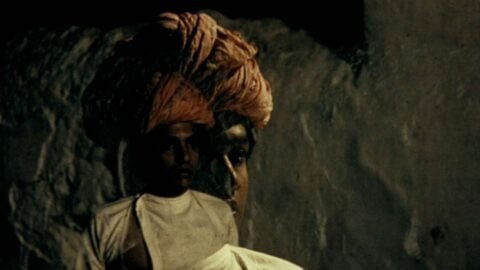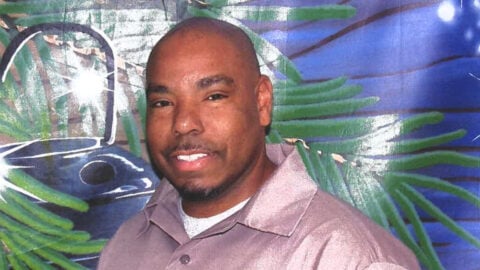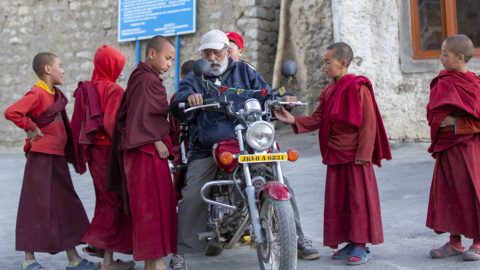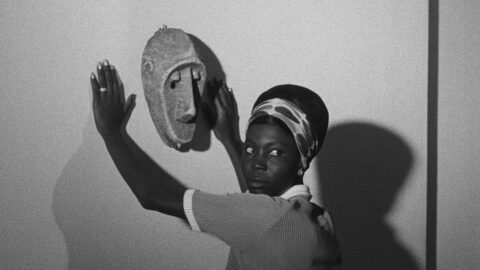Deep Focus: In This Corner of the World
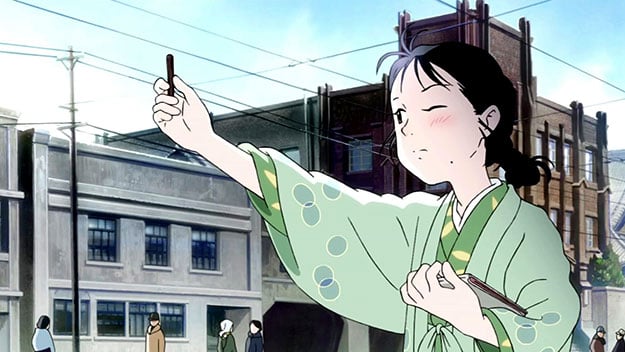
Delicate and rich, In This Corner of the World details a young woman’s delayed coming of age, in and around Hiroshima and Kure before, during, and after World War II. It begins as a portrait of an artist as a young girl. As an innocent daydreamer of primary school age, Suzu uses drawings and storytelling to transform, illuminate, and redeem everyday pettiness. She pictures her mean, obstreperous older brother as a monster: a fantastic two-legged beast, all teeth and fur, resembling Maurice Sendak’s wild things. Suzu delights her younger sister with a tale of how she and a schoolboy outsmart him. Later, Suzu creates a picture of the Seto Inland Sea with white rabbits romping like white caps over waves. She does it as a favor to her childhood crush, Tetsu, a moody boy unable to draw the shoreline view for a class because he’s too full of grief and fury over losing his navy brother to the sea.
During a life circumscribed by family, school, and work in her family’s seaweed farms, Suzu develops an enchanting sensibility—suggestible and fanciful. Those who haven’t read the original manga (by Fumiyo Kono) may spend part of the movie wondering whether her talent will develop and be discovered. Will it transport her beyond the conventional life of a self-sacrificing housewife? This movie is more startling and refreshing precisely because it doesn’t trace the emergence of a sketch artist or painter. Suzu’s art gets subsumed in her overall imaginative and emotional resourcefulness. It’s part of the whole psychological and creative package that enables her to endure the losses and wounds of wartime and the gash in history that is the A-bomb exploding over Hiroshima. Her youthful exercise of creativity awakens her to the recuperative power of imagination.
Co-written and directed by Sunao Katabuchi, a protégé of Hayao Miyazaki’s, In This Corner of the World offers a poignant yet robust depiction of daily life persisting through catastrophe. Katabuchi keeps a large cast and cataclysmic episodes in balance because he hews close to Suzu, a young, suburban Hiroshima woman, as she intuits her way through an arranged marriage. She must take a train to join her husband, Shusaku, in the hillside home overlooking another harbor city, Kure. The one romantic element to their match is that Shusaku remembered bumping into her with his father during a trip to Hiroshima three years before. He held her image in his heart and sought her out.
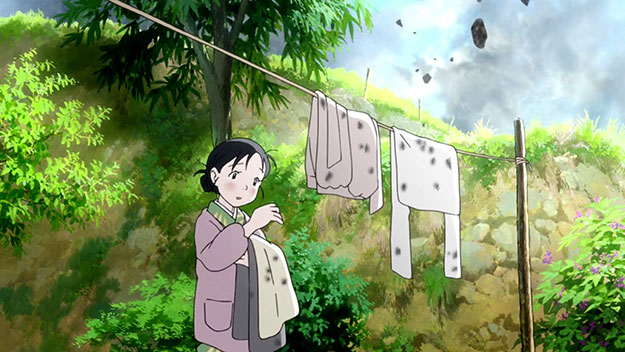
Few acts in this movie, though, including Shusaku’s proposal, can be reduced to one simple motivation. He also wants to get married because his mother has become frail and could use a daughter-in-law to run the house. Suzu does serve her, eagerly—she never stops being full of surprises. Slyly and artfully, Katabuchi packs his narrative with incident and revelation. Epiphanies keep popping out from this director’s meticulous portraiture, his acute observations of habits and gestures. He turns Suzu’s two-steps-forward, one-step-back progress into dynamic motion. We’re delighted to see Suzu catch up to her own feelings. Early on, in her childhood home, we learn that her dreaminess is partly a reaction to her bullying brother. We don’t recognize how much he has affected her until the War takes him away—and Suzu’s sister tells her there’s no one left to oppress her at home in Hiroshima. From the start, we know that Suzu feels tenderly toward her schoolmate Tetsu, a rebel without a cause. But only after he visits Suzu and Shusaku (he’s been serving on a cruiser, docked in Kure’s harbor) do we see how keenly she once ached for him. Shusaku proves his confidence and wisdom—and his love—when he permits Suzu and Tetsu to talk together heart to heart, in private.
What Katabuchi captures throughout is the complexity within the quotidian. In the opening sequence, tiny Suzu revels in Hiroshima’s gay Yuletide shopping and sings about how sharply she “feels” the color of the azure sky. She also wonders, in her song, whether anything will fill the emptiness within. Katabuchi’s loving re-creation of prewar, downtown Hiroshima, with its glittering brass-railed kimono shop, made a powerful connection with native audiences (the film was a major hit in Japan). The director peppers the narrative with the dread and horror of the Pacific War breaking out and then breaking down as he keeps his focus on Suzu moving toward emotional fulfillment.
As fleeting titles mark the passing years (the film starts in 1933 and ends in 1946), the story’s two strands join in complicated knots. Suzu’s wifely duties encompass rationing food not just for her family, but for the entire neighborhood. Later she learns to extend portions and to make them appetizing by mixing them with herbs and plants or by cooking according to the “Increase Food Method” of a feudal samurai. Katabuchi includes a lot of organic slapstick and seriocomic spats in his dramatic recipes. Shusaku works as a judicial civilian officer in the Kure military court before he gets drafted into the Navy. She draws him before he goes. (It’s one of the last pictures we see her compose.)
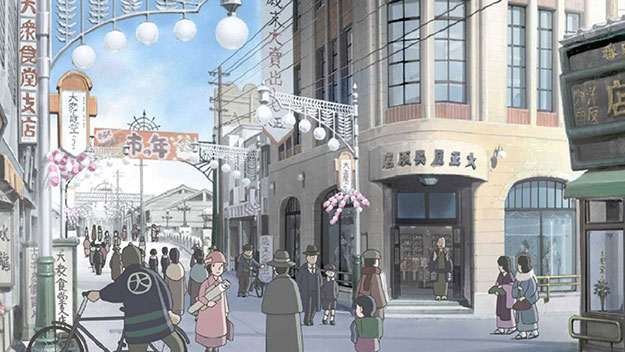
Suzu must constantly re-prove her mettle, especially when Shusaku’s widowed sister, Keiko, returns to the family manse with her little daughter, Harumi, and wants to rule the roost. But this generous mélange of domestic drama and Bildungsroman never devolves into a sob story, and Suzu never registers as a soap-opera heroine, bearing up nobly under multiple calamities, which include a devastating physical injury. She always bounces back: she gets discouraged, confused, or depressed before she puts her chin up and forges a new bond with Keiko or throws herself into services to support the troops. At the news of Japan’s capitulation, she’s furious that her country has “surrendered to violence.” Eventually, her survival reflexes kick in, as she and Keiko stand first sullenly, then thankfully in sloppy-second food lines.
Katabuchi prizes suppleness, responsiveness, and flexibility, in his characters, his drawings, and his storytelling. He establishes a psychological intimacy with Suzu so instinctive that we can read her signals in an instant. At one point, she flinches at Shusaku’s touch. We comprehend that she resents him because she thinks he doesn’t notice how self-conscious she is over a recent bald spot. A minute later, they overhear their niece Harumi chatting about her hair loss. They share a private smile; they’ve revived their understanding.
Visually, the movie goes beyond prewar nostalgia. With a lived-in realism, it takes a vital, tactile, observant view of the past. As a child, Suzu wades through the mud of the seabed at spring tide; as a young wife, she wanders lost through the courtesan district of Kure. Katabuchi intersperses this naturalistic tapestry with splashes of volatile lyricism. In the eyes of Suzu the artist, anti-aircraft blasts become Van Gogh–like starbursts. In the psyche of Suzu the bomb victim, the world goes black, and people register as chalky stick figures.
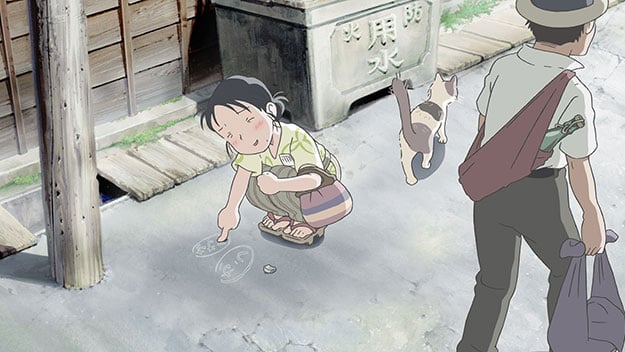
Katabuchi withholds any scenes of Hiroshima on August 6, 1945, until the end. Then he delivers an intense vignette of a little girl clinging to her dead mother until she’s driven away by flies. That child enters into Suzu and Shusaku’s life as they determine to rebuild it. In its climax, this sublime cartoon juxtaposes happiness and heartbreak as skillfully as Trevor Nunn did onstage in the final moments of the RSC’s Life and Adventures of Nicholas Nickleby, when Nicholas hefts a frigid young pauper in his arms—the spitting image of his dead friend Smike—while the caroling ensemble sings about “tidings of comfort and joy.”
At the close of In This Corner of the World, old feelings mellow with new resolve that the work of humanity must go on.
Michael Sragow is a contributing editor to Film Comment and writes its Deep Focus column. He is a member of the National Society of Film Critics and the Los Angeles Film Critics Association. He also curates “The Moviegoer” at the Library of America website.



